Colloquia for Fall 2011
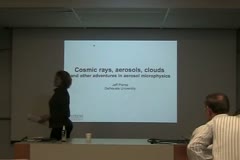
Cosmic Rays, Aerosols, Clouds and Other Adventures in Aerosol Microphysics
November 17, 2011
Jeffrey Pierce
Hosted by Sonia Kreidenweis
Cloud cover has been reported to correlate with the flux of Galactic Cosmic Rays (GCRs) to the troposphere. This potential GCR/cloud connection has been heralded by some as a driver for 20th temperature increases because GCR fluxes decreased in the first half of the 20th century. However, the reported correlations are still controversial, and we are just beginning to understand potential…
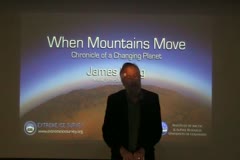
A Year in the Life of the Extreme Ice Survey--and New Directions for the Future
November 09, 2011
James Balog
Hosted by John Calderazzo
National Geographic adventurer and photographer James Balog will talk about how and why he founded the Extreme Ice Survey, connecting art and science to communicate to the general public how climate change and other human activities impact the environment. Since 2007, with the involvement of scientists and educators, Balog has been using time-lapse imagery, making the world's most extensive…
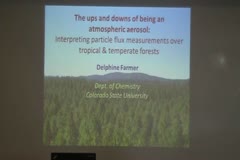
The Ups and Downs of Being an Atmospheric Aerosol: Interpreting Particle Flux Measurements Over Tropical and Temperate Forests
November 03, 2011
Delphine Farmer
Hosted by Jeff Collett
We made the first chemically-resolved aerosol flux measurements over temperate and tropical forests during the BEARPEX-07 (Biosphere Effects on AeRosols and Photochemistry EXperiment, Blodgett Forest, California) and AMAZE-08 (AMazonian Aerosol characteriZation Experiment, Brazil) campaigns using a high resolution time-of-flight aerosol mass spectrometer and eddy covariance measurements. While…
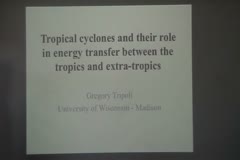
Tropical Cyclones and Their Role in Energy Transfer Between the Tropics and Extra-Tropics
October 20, 2011
Greg Tripoli
Hosted by Sue van den Heever
Moist convective systems in the tropics inject large masses of high entropy / high angular momentum air into the upper troposphere (the so called over world) inflating a "tropical tropospheric energy bubble" (TTEB). To complete the global energy cycle, the mass of air contained in the TTEB must migrate to higher latitudes where its energy can be radiated to space. Since most tropical…
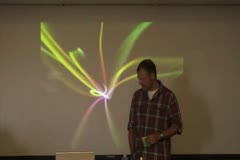
Response of precipitation to climate change: theory, simulations, and observations
October 06, 2011
Paul O'Gorman (MIT)
Hosted by Thomas Birner
Climate change is expected to strongly perturb the atmospheric hydrological cycle, with potentially large changes in the distribution of precipitation. In this talk, I will focus on the factors controlling changes in mean precipitation and changes in intense precipitation events (referred to as precipitation extremes). Changes in mean precipitation will be discussed within the framework of the…
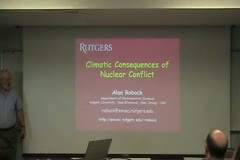
Climatic Consequences of Nuclear Conflict: Nuclear Winter Still a Threat
September 29, 2011
Alan Robock
Hosted by Eric Maloney
A nuclear war between Russia and the United States, using the reduced arsenals of 4000 total nuclear weapons that will result by 2017 in response to the New START treaty, could still produce nuclear winter. A nuclear war between India and Pakistan, with each country using 50 Hiroshima-sized atom bombs as airbursts on urban areas, could produce climate change unprecedented in recorded human…
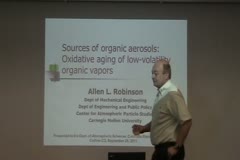
Measurement and simulation of fine particle emissions from combustion systems
September 26, 2011
Allen L. Robinson
Hosted by Jeff Collett
Atmospheric particles play an important role in climate forcing; they are also strongly associated with adverse human health effects. Motor vehicles, wood stoves, and other combustion processes are major sources of atmospheric particles. This talk summarizes recent field, laboratory, and modeling findings on organic particle emissions from combustion systems. The results reveal a dynamic…
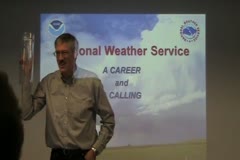
National Weather Service Field Operations: Accomplishments, Challenges, and Opportunities
September 15, 2011
Steve Apfel, Nezette Rydell, Jennifer Stark, Paul Wolyn
Hosted by Nolan Doesken
Operational meteorology is alive and well along the Front Range of the Rocky Mountains. In this seminar, we will all have the opportunity to meet the MICs (Meteorologists in Charge) from each of the nearest National Weather Service Offices (Cheyenne, Boulder and Pueblo). They will share their perspectives on current NWS operations and will describe the greatest current weather forecasting…
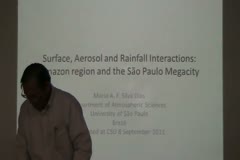
Surface and Aerosol Effects on Rainfall: Amazon Basin and the Megacity of Sao Paulo, Brazil
September 08, 2011
Maria Assunção F. Silva Dias
Hosted by Wayne Schubert
Possible effects of surface and aerosol changes on rainfall in the Amazon Basin and in the Mega-city of Sao Paulo, Brazil, will be presented as part of an effort of cause attribution of observed changes. In the Amazon basin most of the human influence is through deforestation and biomass burning. In Sao Paulo, urbanization including the heat island and air pollution have changed the…
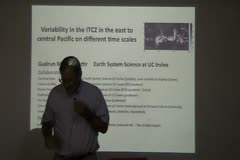
East Pacific ITCZ Variability Over Three Decades of Satellite Data
September 01, 2011
Gudrun Magnusdottir
Hosted by Wayne Schubert and Thomas Birner
The intertropical convergence zone (ITCZ) is one of the most recognizable aspects of the global circulation as seen from space yet we are hard pressed to come up with a clear definition of the ITCZ as seen in instantaneous cloud fields. For detecting this feature, we are guided by the principle of continuity in space and time, and reconciling more than one meteorological field. I will describe…
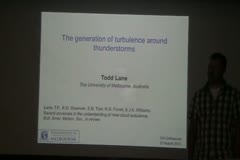
The Generation of Turbulence Around Thunderstorms
August 25, 2011
Todd Lane
Hosted by Thomas Birner
Anyone who has flown in a commercial aircraft is familiar with turbulence. Unexpected encounters with turbulence pose a safety risk to airline passengers and crew, can occasionally damage aircraft, and indirectly increase the cost of air travel. Deep convective clouds are one of the most important sources of turbulence and cloud-induced turbulence can occur both within clouds and in the…
